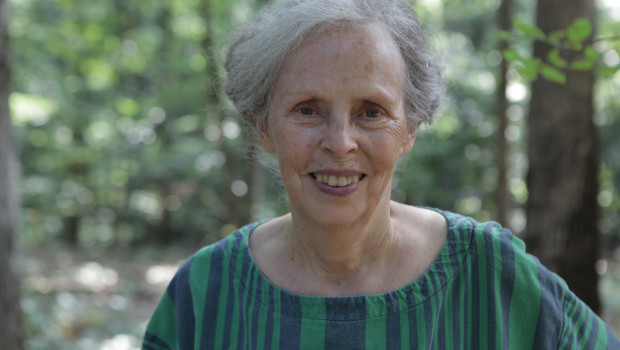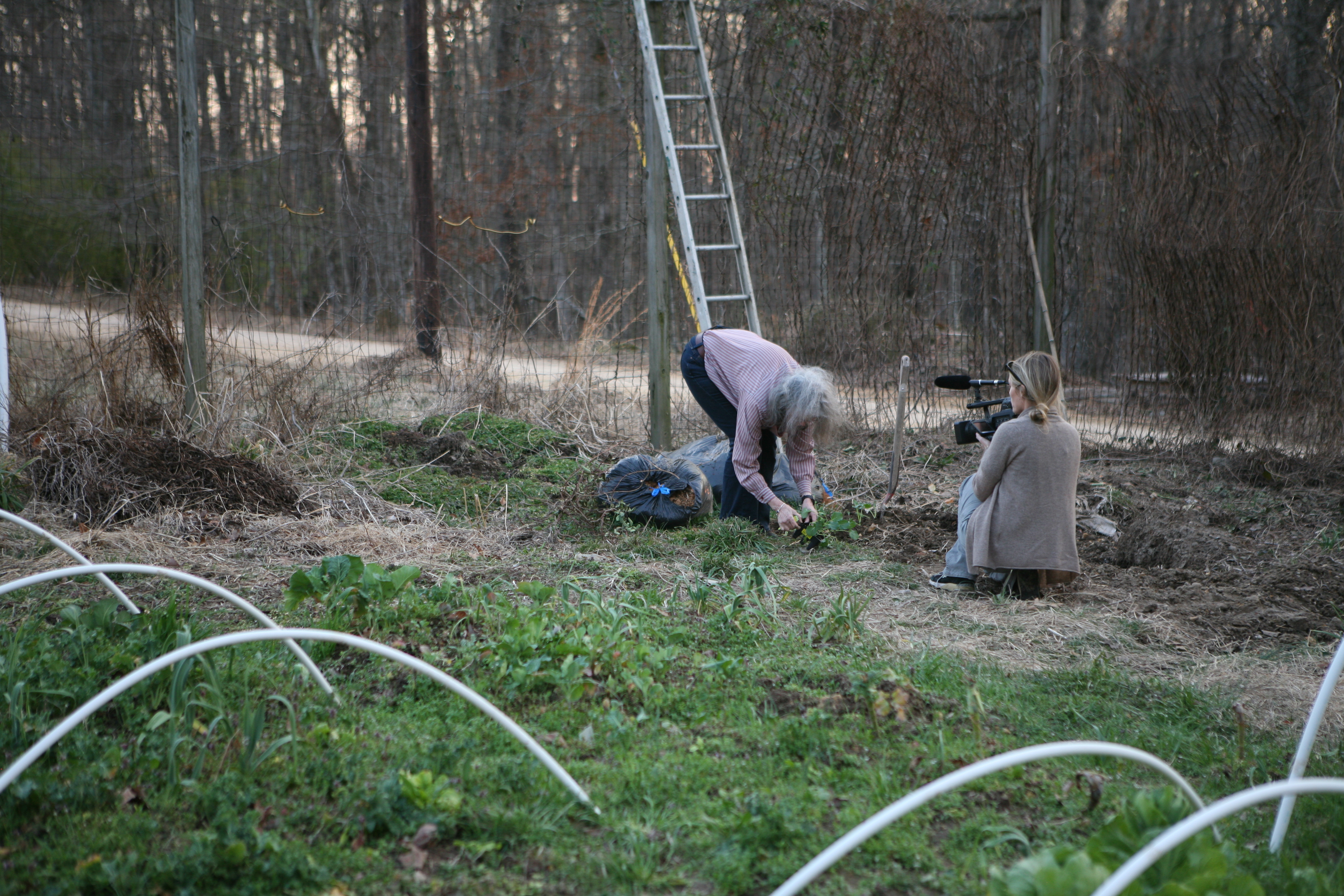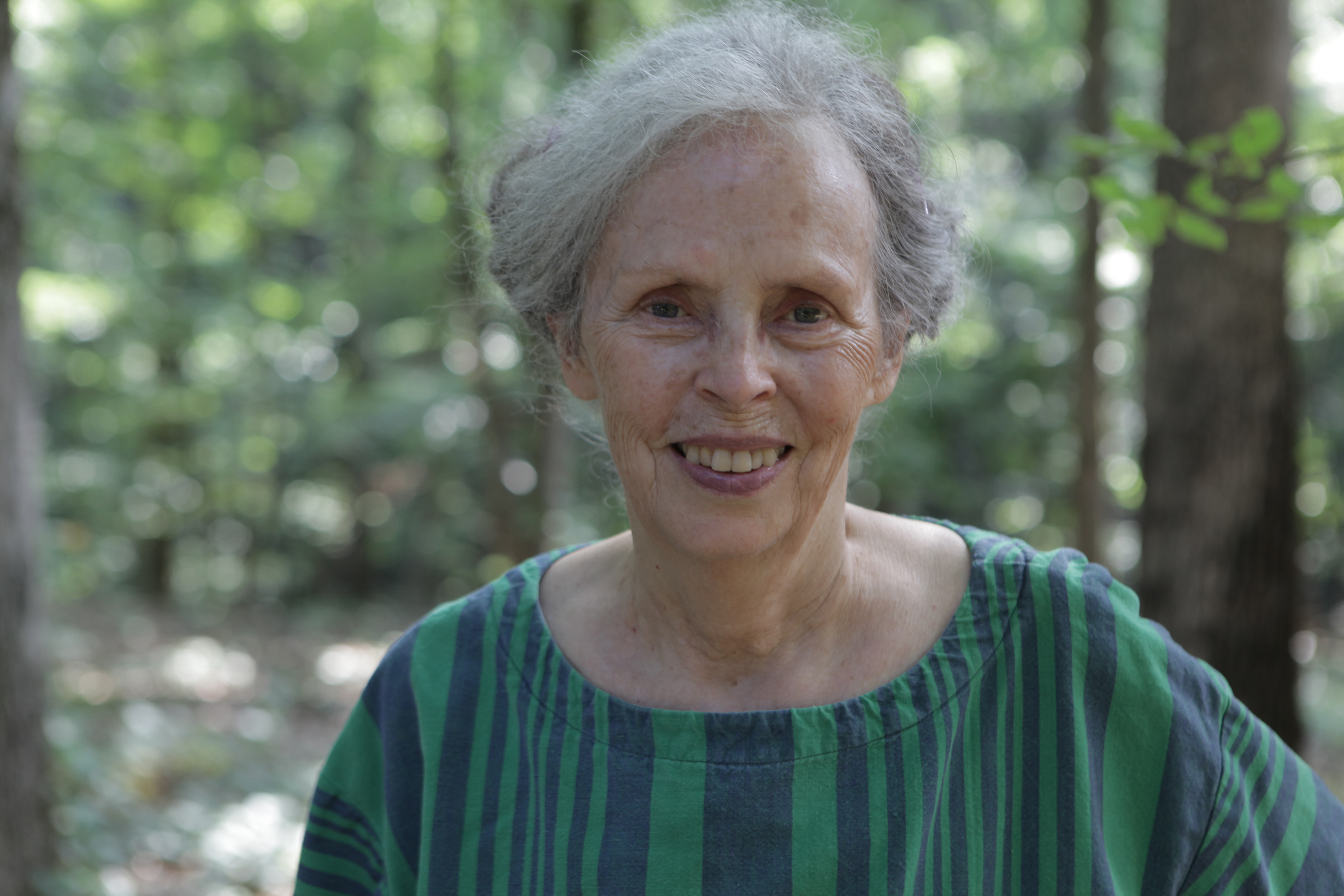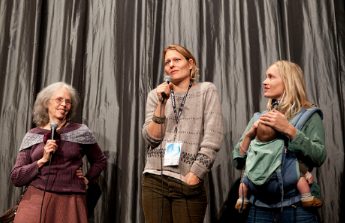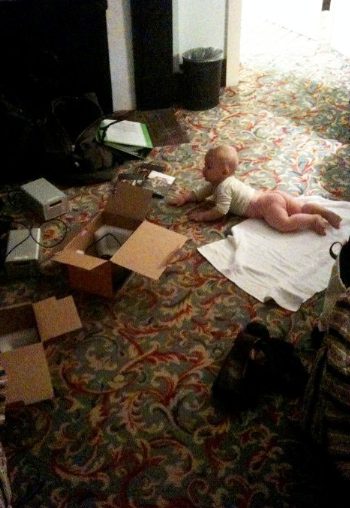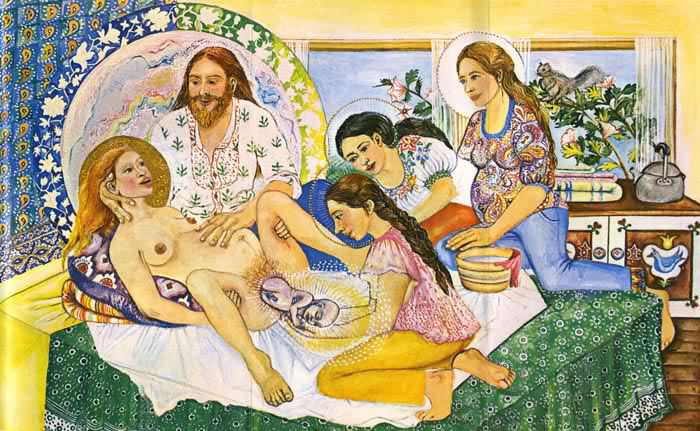BIRTH STORY: An Interview with Mary Wigmore + Sara Lamm
When the film Birth Story: Ina May Gaskin & the Farm Midwives opens, the documentary’s primary subject, midwifery pioneer Ina May Gaskin is addressing an audience. She says something to the effect of ‘Women think they can avoid the pain of pregnancy through a c-cection.’ I nearly gasped aloud! Though I’m not even pregnant yet – just stuffing my vagine full of Viagra suppositories to build up my uterine lining for an embryo transfer – of course I think about the moment of childbirth and of course I’m terrified by the thought of it. What if I spend 48 hours trying to push a watermelon through my donut, only to then end up with a c-section anyway? That totally seems like something that could happen to me. Feeling like I have very little to prove, I was seriously planning on scheduling myself a c-section until I saw Wary Wigmore and Sara Lamm’s wonderful film about Ina May Gaskin, author and visionary and midwife. The film explores how the legendary Farm commune came about (perhaps you vegans have eaten from their classic cookbook?)and how a young Ina May, along with the other women in the commune, just started helping one another birth their babies. From there, a feminist midwife and speaking career was born, spanning decades. The movie is perhaps most fascinating for the archival footage of hippie wimmin giving birth at the Farm’s birthing center. Having never seen a real life birth, all I got to go on is TV and movie births, and the black-and-white footage is waaaaaay different than the scenes of women screaming and crying in paper johnnies. These women are enduring something primal, but they look super high on pregnancy hormones and seem like they feel kinds groovy – especially when the screen becomes suddenly full of the big, bearded faces of one of their men who lean in for a makeout. It’s hard not to watch this footage and not feel like, I want that experience (substituting my fiance’s un-bearded face for the mountain man, of course). I hunted down the filmmakers and found them delightful and inspiring, as women and friends and feminists and artists and moms. And I can’t recommend their movie enough – it’s a revelation, even for everyone who knows already knows the Western way of childbirth is sketchy. Birth Story is easily purchased from the film’s web site, along with some nifty related merch, like tote bags proclaiming a favorite quote from Ina May: Your body is not a lemon. – Michelle Tea
Mary Wigmore
MUTHA: I read that you your collaborator, Sara Lamm, passed you Ina May’s book Spiritual Midwifery and it helped you feel less afraid. What were your fears then, and what did find in the book that comforted you?
MARY WIGMORE: It seemed like a lot of the stories that were being passed around were really scary, at times kind of grisly. Grisly is a rough word, but they had moments where they had to be rushed in for a c-section. And just the unknown of it. You don’t know what your body is going to do, you don’t know how you’ll feel, what will happen. I think there is fear in the unknowns. So when I read the book and all the stories were so positive – and of course there are moments of great struggle, but they came through them and they had this beautiful experience and their partners were there helping them and these women were there helping them and I thought: this could be this great, fun adventure. This is a part of life and women have been doing this my whole life.
In the end I ended up having a c-section; my son was breach. But I still felt like these stories really helped me. And then I had another baby and I was able to have a natural birth. And that’s probably because I spent these three years with these women. My nurses never saw VBAC before (Vaginal Birth After Cesarean). I felt like my time spent with them just made me feel stronger and it did take the fear out if it. I think people are really hungry for those kind of positive stories and it seems like by exploring Ina May’s experience it starts a conversation about that and about what could be.
I looked for a movie about Ina May. I figured there must be something, especially because Spiritual Midwifery was such a visual book. Sara similarly thought this would be a great film, and Sara had a chance to meet Ina May at her doula’s house. That night Sara called me and said, We gotta do it. We decided to go to the Farm and do one interview with Ina May, and we really hit it off. We were doing it in a very DIY way and I think that she recognized that they had also worked in that way, and there was a nice echoing of that. She said, ‘I made all my decisions on my life based on intuition, and I feel like you guys are the right people.’ She’s a Pisces. Her birthday is International Women’s Day.
MUTHA: You have a toddler, and were you also pregnant while filming? How did you balance the rigors of making a film with everything else?
MARY WIGMORE: I got pregnant while we were editing. I had my baby four days before our film premiered at the L.A. Film Festival. But on the first stretch Sara had a 5 year old, so her son came along for the first 2 years of filming. Sometimes we’d bring our kids and it was 2 mothers trying to work it out. It was like the best movie ever to be pregnant or have little kids on, because they were so understanding.
MUTHA: Did you learn a lot about mothering while shooting this particular film?
MARY WIGMORE: I did. Of course I feel like even if I wasn’t making a film you’re always learning about being a mother. It was definitely challenging to make a film and have little kids. And to figure out the balance, a lot of it was Sara and I supporting each other through that and being: This is what we love to do and this is good for them, to see us doing what we love to do. My mother never really found her thing. She did in some ways, but I always felt it was really important to follow my passions, as cheesy as that sounds. It’s super important and there are times of sacrifice, but we brought our kids and because we were co- directing we had a bit more leeway, and we did it in the way we could do it. I learned a lot about birth. I learned a lot about how quietly loving these women were while taking care of other women. I learned about trusting my body. It’s kind of endless. But specifically being a mother, I think I learned a lot about making peace with following your dreams and also being a mother, and how that can inspire them to be the people they want to be. That’s something I’m still learning. I don’t feel totally comfortable with it yet. Also, learning to say ‘No, I can’t do that, I have to be with my family.’ It was a perfect project for this time in our lives.
MUTHA: How did moms feel about you being present with cameras during so many intimate moments, including birth?
MARY WIGMORE: You know, we had been filming for almost a year and a half and the midwives would say, ‘These girls’ – they always called us ‘the girls’ – ‘They’re mothers, they’re sweet, they’ve been here, do you want to be involved?’ It really came through them and that helped us a lot. The midwives trusted us. We were also just the two of us, Sara and I shooting most of the time. You know, it was an honor. It was amazing to be able to witness birth like that, and to be invited into such an intimate moment. The two births that we filmed – one of the women is a childbirth educator and is on the road to becoming a midwife. The other woman was a nurse and very committed to natural birth. They wanted to spread the word. They believe in Ina May and what she’s doing, and they felt they could help people by allowing us to be there and show birth in this way. One of the things we have sort of come to is, midwives are the experts in normal birth because they see it without intervention. Those two women wanted to show that. There were other women who let us film their prenatal and postpartum business. People were very open. They were happy we were making the film.
MUTHA: I think it is a totally radical move to show footage of a woman giving birth. I was shocked when I realized how I’ve never really seen it.
MARY WIGMORE: I hadn’t either. Isn’t that wild? Its like this great mystery, and yet we all come into the word that way. We really felt committed to showing birth from the very beginning no matter what that meant for our distribution. That was always very important to Sara and me. And also, when we began we really had no idea that all that archival footage existed, so that was this great gift. These women had had the foresight to film everything, and that was incredible. Ina May’s message is so radical, but she’s really just saying your body works and you can do this. And yet, it’s so radical.
MUTHA: How long did you stay in Tennessee to film? Did you stay at the Farm? What was that like?
MARY WIGMORE: We stayed with a family, these people called Will and Deb. We stayed in their house and they made us breakfast and dinner. We rented rooms, it was great. We would just sit with them at the table and they would tell us stories, and they really pointed us in interesting directions. I think we spent a total of six weeks at their house over a couple of years, so we really got to know them. We would shoot all day. We shot everything in natural light, so we would be done by the evening. Long days. We went there every season.
MUTHA: Why did you and Sara decide to have the film be a collaboration?
MARY WIGMORE: We just decided to make the film together from the very beginning. We learned so much about supporting each other. We could not have made this film without one another. It wasn’t a big decision; when she called me that night and said ‘There’s no film,’ we just said lets do it. We were introduced through a mutual friend like eight years ago. Sara made another film, Dr. Bronner’s Magic Soapbox, and I made a film that is forty minutes, Ashtanga, NY, about a yoga guru.
MUTHA: How are you managing being a working artist and being a mom?
MARY WIGMORE: The way that I work, sometimes it’s quite busy when you’re shooting and stuff but the rest of the time I’m around. I pick up my son from school and then work furiously, trying to figure it out. There’s no good way. It’s challenging. You know – with the help of my husband and babysitters. It’s a lot of perseverance. I don’t know. It’s hard. But it’s kind of an obsession, and its good to have obsessions. It’s good to be so interested in something that you have to work on it. I love just spending the whole day with my kids for days, and then I feel that desire to go work on things and help make the world a better place and think in a bigger way. It’s less thinking about it and more comes from within. I like filming things.
MUTHA: Where is the film at now, with distribution, etc?
MARY WIGMORE: It is out. You can buy it digital, DVD, it’s on iTunes, so people can watch it at home. And it also had a theatrical release all over the country, which was amazing, and it did really well. There are some educational screenings, Universities are bringing it. It’s doing well, it’s so exciting people are responding to it. We really connected with our audience through social media so that’s a whole new world as a filmmaker, to cut out the middleman.
MUTHA: Were there other books or resources that you came upon that were worthwhile?
MARY WIGMORE: My friend Ceridwen Morris blogs for Babble, but she wrote a book called From the Hips: A Comprehensive, Open-Minded, Uncensored, Totally Honest Guide to Pregnancy, Birth and Becoming a Parent, which I thought was sweet and light. I loved Ina May’s Guide to Childbirth, too. I looked at everything, you sort of look at everything and figure out what works for you.
MUTHA: Are you and Sara working on something new?
MARY WIGMORE: The film just came out a couple weeks ago, so we’re not onto anything else now but hopefully in the fall. I think we’re just excited to hang out with our families for a little bit. I think we’re sort of collaborators for life. We had 5 babies born to our crew during filming.
SARA LAMM
MUTHA: I know that you passed Spiritual Midwifery to Mary Wigmore, which sparked this whole project. How had you come upon the book, and what made you pass it to Mary?
SARA LAMM: A friend – a Brooklyn friend – it’s a very Brooklyn – y book, and probably very San Francisco, too – passed it to me when I was pregnant and said, ‘This is the best book you’ll read while you’re pregnant’, and I definitely found that to be true. Especially as I got closer to labor it became the only book I wanted to read. I guess I felt it was preparing my mind in a very positive way for the transformation to come.
I think it has a tradition of being passed like that, from friend to friend. When you have a friend who’s pregnant everyone wants to share the story that meant the most to them. For me, this was the book that did that for me. I turned to it so much when I was pregnant, for pleasure and inspiration and companionship, so I bought it for Mary when she was pregnant.
MUTHA: What was it like filming with your kids in tow?
SARA LAMM: When we started I had a two and a half year old and a four month old. I was really like, how on earth am I gonna make this happen? And it was really the support of our directing partnership that allowed it to happen. Mary said, we’re just going to do it, we’re going to figure out how to do it. So we really looked out for each other and tried to be as understanding as we could when family issues crept in on the production. In a way this particular project was the best project of the time, because I can’t imagine any other doc setting where you could travel to set with your kids and breast feed them and have the people on the other side of the set think that was great. Our experiences with our children were supporting the story we were telling. I remember at one point Mary and I were setting up a shot and Pamela, one of the midwives at the shoot was like, ‘Oh, you’re just like midwives,’ because we were working so well together, silently passing each others things. It was the highest compliment. I do think the terrain of how do moms make creative work seems like such a important issue. The only relief from the pressure and the challenge of it seems to be sharing our stories.
MUTHA: How did you meet Ina May?
SARA LAMM: Ina May came through L.A, she travels internationally, giving talks, and she was in L.A. staying at my doula’s house. I had just given birth a few months earlier and my Doula said ‘You’ll never guess who’s at my house, Ina May, come on over.’
When we learned there was no movie Mary said, lets go do it. It took us about a month to regroup after our first meeting, and then we went to our first trip to Tennessee.
MUTHA: What was it like to be at the Farm?
SARA LAMM: We’d read Spiritual Midwifery, and I guess we were so immersed in that world that we thought the Farm was going to be like the world that was documented in that book. In that world in that time no one was drinking coffee and no one was drinking honey because it was a an animal product. We were very panicked about where we were going to get our coffee in the morning. The people who had founded it were all in their early 20s; now they are up into their 70s. It has evolved and grown up, basically. It was such a delight, it’s so interesting to meet a group of people who came together in agreement about what their values were and how they wanted to live. Even though they’ve changed and they’ve had to adapt and it hasn’t always been easy I think it’s so impressive that it’s still there. For us to know that long ago a group of people came together and said, ‘This is how to we want to live, we want to speak to each other compassionately’ and that they’ve managed to keep doing that, I think it has a ramification for our own lives in terms of the scale of what we’re capable of building in our own communities.
They also make the great point of saying that there is the Farm that is the place and the Farm that is the culture, and the Farm that is the culture is so widespread. When you realize that at its peak there were people like Al Gore going through those gates and spending time there – Al Gore was a journalist, and he wrote an article about the Farm. There were people all over the world who were touched by what was happening at the Farm. It’s a cultural and societal force that is not really well known.
MUTHA: Did you have a vision at the outset for what the film would be?
SARA LAMM: We knew we wanted to try to be observational where we could. We knew we wanted to create a portrait of this particular group approach to birth. But it evolved when we learned there were great archival materials and realized that would be a big part of the film. That was a treasure trove and discovering it just broadened what the film could become. We realized we had to make a choice between the larger subject of the Farm and the story of the midwives. At one point we had a three hour cut of the film and we had to cut it away and cut it away until what was left was what was essential to ourselves, birth and this culture we were documenting. But we couldn’t have said that at the outset that we’d be having to chose between the Farm and the midwives. And that was hard because the Farm is such an interesting place. The Farm has reached into food – there are people working today in the larger organic farms that have their roots at the farm. Its so interesting.
MUTHA: Have you faced any problems as a result of showing the birth footage?
SARA LAMM: Well, I think from an audience perspective people have been really really warm toward the film. And there seems to be a great craving, in at least our particular audience, to see birth in this particular way. We won the audience award at the L.A. Film Festival, we couldn’t believe it. We sort of braced ourselves for people to walk out, we had no idea we’d be instead be walking into a room of people with tears in their eyes saying, ‘Thank you for showing this.’ One midwife came up to me and grabbed me and said, ‘Thank you for making this, it is so healing.’ There is a yearning for compassionate treatment of women’s bodies, and to tap into that was really positive.
We knew we’d never find a traditional distributor who would pick it up because there are a lot of vaginas in the film. The way that we’ve managed to distribute the work is in its own way radical because its made for the people by the people. We can directly connect with the people who know the value of the work. It’s a challenging time to be a filmmaker because economically it’s tough but if you have a successful Kickstarter campaign you can make the movie for the people you’re making the movie for and that’s really thrilling.
MUTHA: What were your own births like?
SARA LAMM: I gave birth with a midwife in L.A. in a hospital both times. They were just the best, just the best. I loved every minute. I would do it again if I could figure out how to juggle one more kid.
The first trimester was hard, but after that it was – I just think giving birth is the most exciting thing in the world. I felt the oxytocin rush the midwives talk about in the film, the overwhelming happiness holding my babies. It was legit, the high. It was great. Not everyone feels that way and I definitely felt it the second time more than the first. It’s trickY – when you talk about birth you never want to make people feel like they failed if they didn’t have a particular kind of birth. It’s hard to maintain an inclusive stance while maintaining that in the majority of time we are capable of giving birth. That’s the great challenge. I do think skilled midwives are capable of helping women do what’s right for them.
MUTHA: How do you manage being a working artiat and a mom?
SARA LAMM: I think meditation is really helpful. And I think strong female friendships are really helpful. And I think help is really helpful. And by help I mean all kinds of help, all kinds of help from any direction. There’s the tendency to think you can get it done alone and as soon as you have kids its obvious, if it wasn’t before, that everybody has to pitch in.
MUTHA: What have you found to be the biggest misconceptions about childbirth?
SARA LAMM: Well, I think in our culture today people are prepared for it to go poorly. And if there is one hope for the film is it that is could help expand people’s ideas of what’s possible. And help bolster the idea that it might go just beautifully. And our minds and the minds of our care providers have something to do with the outcome.
MUTHA: What are yours and Mary’s astrological signs?
SARA: I’m a Leo; Mary’s a Scorpio.

